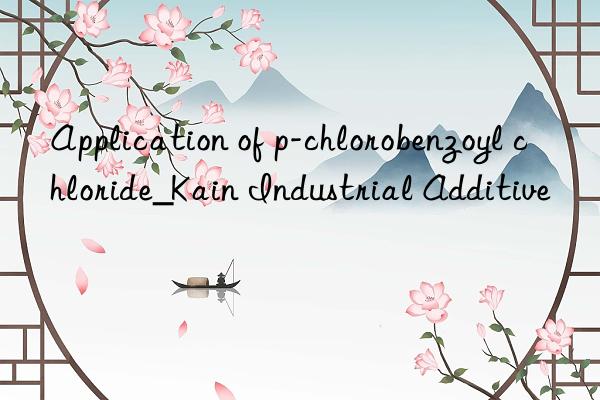
Background and overview[1-2]
With the rapid development of polymer materials, p-chlorobenzoyl chloride, as an important chemical intermediate, has attracted more and more attention from researchers. Its excellent properties are widely used in pharmaceutical intermediates, dye intermediates and preservatives. etc. have been widely used. The existing preparation method generally uses p-chlorotoluene, chlorine, azobisisobutyronitrile, ferric chloride, and water as raw materials, and produces qualified p-chlorobenzoyl chloride through steps such as chlorination, hydrolysis, and distillation; the tail gas is processed After washing with water or alkali, it is discharged at high altitude, and hydrochloric acid and sodium hypochlorite are by-produced. Disadvantages of this preparation method: 1. The chlorination reaction time is long. 2. The reaction has many side reactions, many impurities, and low product yield.
Apply[3-5]
P-chlorobenzoyl chloride has gradually become an important chemical intermediate. Examples of its applications are as follows:
1) A method of catalytically synthesizing 4-chloro-4’-methoxybenzophenone using anisole and p-chlorobenzoyl chloride as starting materials and using new magnetic nanoparticles supported Lewis acid as a catalyst. 4-chloro-4'-hydroxybenzophenone (CBP for short), the molecular formula is C13H9ClO2, the molecular weight is 232.66, it is an off-white or off-white to reddish white crystal, the melting point is 177-181℃ , with a boiling point of 257°C), is a key intermediate for the synthesis of the anti-hyperlipidemic drug Fenofibrate and an important raw material for pesticides and heat-resistant polymers. The application of fibrate intermediates is particularly important. There are usually two main methods for the synthesis of 4-chloro-4’-hydroxybenzophenone: one is the Friedel-Crafts acylation reaction method, and the other is the Fries translocation rearrangement reaction method. Using a new type of magnetic nano-loaded Lewis acid as the catalyst has the following advantages: 1) The magnetic nano-loaded Lewis acid catalyst uses less amount and can be reused; 2) The reaction time is greatly shortened and the conversion rate and yield of the reaction are improved; 3) Magnetic Nano-supported Lewis acid catalysts are easy to separate and recover quickly, have simple procedures and relatively low production costs.
2) Preparation of 4-hydroxy-4’-chlorobenzophenone, which belongs to the technical field of catalytic synthesis of 4-hydroxy-4’-chlorobenzophenone. This method uses p-chlorobenzoyl chloride and anisole as starting materials, aluminum trichloride as a catalyst, and chlorobenzene as a solvent. After a Fuckers reaction, demethylation, ice hydrolysis, filtration, and drying are performed to obtain 4-hydroxy-4 '-Chlorobenzophenone, in which the chlorobenzene mother liquor obtained by filtration is washed with water, distilled and recovered for recycling, the hydrogen chloride gas generated during the reaction is absorbed with water to obtain a hydrochloric acid product, and the acid water obtained by washing is neutralized with ammonia water and filtered , drying and roasting to obtain alumina for reuse. This method has convenient post-processing, no environmental pollution, short reaction time, high product yield and low overall production cost, and is conducive to realizing large-scale industrial production.
3) Preparation of a fluorine-containing indole with a substituent on the nitrogen, especially a synthesis method of 3-methyl-2-trifluoromethyl-N-(4-chlorobenzoyl) indole. The synthesis method of the present invention has the following steps: add 3-methyl-2-trifluoromethylindole dissolved in tetrahydrofuran to a mixed solution of sodium hydride and dimethyl sulfoxide in an ice-water bath, and stir for 1 to 1.5 hours. Then add p-chlorobenzoyl chloride dissolved in tetrahydrofuran under an ice-water bath, and continue stirring at room temperature for 2 to 3 hours; after the reaction is completed, pour the reaction solution into water, extract with ethyl acetate, combine the organic layers, and wash twice with water , and dried over anhydrous magnesium sulfate; then spin off the ethyl acetate and recrystallize from ethanol to obtain colorless crystals of 3-methyl-2-trifluoromethyl-N-(4-chlorobenzoyl) indole.
Preparation[1-2]
Method 1: A method for preparing p-chlorobenzoyl chloride, which is characterized in that: p-chlorotoluene, chlorine gas, triethanolamine, azobisisobutyronitrile, thionyl chloride, and ferric chloride are used as raw materials. Chlorination, hydrolysis, distillation. Specific steps: (1) Chlorination: Add the raw material p-chlorotoluene into the reaction kettle, stir, add triethanolamine into the reaction kettle, and stir for 30 minutes; add thionyl chloride, stir for 10 minutes, then slowly heat up, add azobisiso Butyronitrile, react with chlorine gas to obtain p-chlorotrichlorotoluene; (2) Hydrolysis: Put the p-chlorotrichlorotoluene obtained in step (1) into the hydrolysis kettle, add the catalyst ferric chloride, and add water dropwise to obtain p-chlorotrichlorotoluene. Crude benzoyl chloride; (3), Distillation: Distill the crude p-chlorobenzoyl chloride to obtain the product;
Method 2: The continuous production process of p-chlorobenzoyl chloride is as follows: (1) Add 498kg p-chlorobenzoic acid and 382kg thionyl chloride into the reaction kettle, and then add 0.249kg N, N-diethylaniline React for 4 hours until no gas emerges, then continue to keep the temperature for 1 hour, distill under normal pressure to recover unreacted thionyl chloride, and obtain crude p-chlorobenzoyl chloride; (2) Add crude p-chlorobenzoyl chloride to thin film evaporation In the device, the feed flow rate is 3.7kg/min, the vacuum degree is adjusted to 750mmHg, and vacuum distillation is performed at 115°C to obtain 545kg of p-chlorobenzoyl chloride, with a yield of 97.9%. After testing, the concentration of p-chlorobenzoyl chloride is Chromatographic content 99.1%.
Main reference materials
[1] CN201710609022.1 Preparation method of p-chlorobenzoyl chloride
[2] CN201510933074.5 Continuous production process of p-chlorobenzoyl chloride
[3] CN201610575596.7 A preparation method of fenofibrate key intermediate 4-chloro-4’-hydroxybenzophenone
[4] CN201410115108.5 A clean method for preparing 4-hydroxy-4’-chlorobenzophenone
[5] CN200610026202.93-methyl-2-trifluorocarbon�-N-(4-Chlorobenzoyl)indole



 微信扫一扫打赏
微信扫一扫打赏
